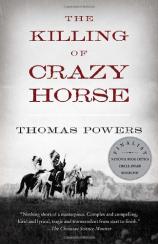The Killing of Crazy Horse
Review
The Killing of Crazy Horse
The title of this wide-ranging book is misleading. Events leading up to the killing of the great Sioux Indian chief Crazy Horse at a military post in western Nebraska in 1877 take up less than 100 of author Thomas Powers’s 467 pages. The rest of the book gives us an immensely detailed and far-reaching account of our government’s wars against the Plains Indians in the 1860s and 1870s. It also serves as a vivid crash course in Plains Indian culture: their customs of marriage and divorce, religion, war rituals, funeral customs and sexual practices.
Historians have worked this inexhaustible lode of history and anecdote for many years, but few have approached the level of detail that Powers reaches. His book is also notable as an honest effort to tell the story from both sides --- Indian and white man --- focusing on what Powers calls “the primal question of history --- what happened?”
Crazy Horse, an Oglala Sioux, was one of the greatest of the warlike Indian chiefs on the western plains. He harbored a deep distrust and suspicion of the white man, but he was a thinker and a brooder who spoke little. No photograph of him is known to exist, and no one knows where his body is buried. Among many other exploits, he was in the thick of the 1876 battle at Little Big Horn in which George Armstrong Custer and his entire force were slaughtered. The exact circumstances of Crazy Horse’s death are not clear even today, 133 years after the fact. It could have been a tragic accident; it could have been deliberate murder; it could even have been both. Powers gives us the facts as he has researched them, but delivers no verdict.
There is no doubt that the U.S. government and military wanted the Plains Indians “out of the way” --- which was understood as a euphemism for eventual extermination. There were several reasons --- they wanted the Indians to give up the Black Hills of South Dakota where gold had been discovered, and they wanted the Indians kept far from the route of the new transcontinental railroad project. To accomplish these ends, they were willing to sweep aside previous treaty agreements and make promises they had no intention of keeping. General William T. Sherman laid out the government’s strategy in plain English: “Remove all to a safe place and then reduce them to a helpless condition.”
It is not a pretty story. Indian resentment and hostility toward the white man was stoked to the point of warfare, while at the same time the various Indian nations complicated matters even more by constantly warring against each other. Crazy Horse was a leader of Indian warfare against the white man. Powers details several of his major battles in often gruesome detail. He devotes an entire minutely detailed chapter to the Little Big Horn disaster --- again without taking sides himself. His account of the eventual capture of Crazy Horse reaches an almost photographic level of detail.
Crazy Horse was lured into a trap. He did not realize until it was too late that he had been taken prisoner by deception and would not be allowed to plead his case to his captors. There was a confused outdoor melee of Indians, soldiers and onlookers during which the great chief was bayoneted twice by someone and died later that night. There was a crossfire of accusations afterward, but Powers concludes that no one now living knows the truth for certain.
This book perhaps tells you more than you really need to know about its broad subject, but it has a number of outstanding virtues that make it well worth reading. First is its obvious fairness to both sides. Add to that its vivid cast of secondary players, people you never heard of who played crucial roles in the unfolding drama. There was General George Crook, a solitary strategist and thinker who felt underappreciated and misunderstood; Billy Garnett, the half-breed translator who felt himself part of both camps in the struggle; Frank Gruard, a somewhat shady and untruthful operator who nonetheless performed important service for both Indians and whites; Lieutenant William Clark, an army officer of integrity who found himself in a terribly uncomfortable position; and a colorful gallery of other players, both white and Indian. At the final crisis, the Indians themselves were divided --- some siding with Crazy Horse, others with his white captors.
Another major asset of the book is the long litany of picturesque Indian names that run through it like a strain of exotic verbal music: Touch The Clouds, Kills Plenty, Wooden Leg, Spotted Tail, He Dog, Horn Chips, and dozens of others. My personal favorite is Young Man Afraid of His Horses.
Powers has a gift for humanizing people on both sides that brings them beautifully to life. Crazy Horse himself leaps off the page as a gifted but inarticulate leader who seems to have given up hope at the last crucial moment of his life and walked proudly but reluctantly to his own doom.
Reviewed by Robert Finn on October 31, 2011
The Killing of Crazy Horse
- Publication Date: November 1, 2011
- Genres: History, Nonfiction
- Paperback: 592 pages
- Publisher: Vintage
- ISBN-10: 0375714308
- ISBN-13: 9780375714306




